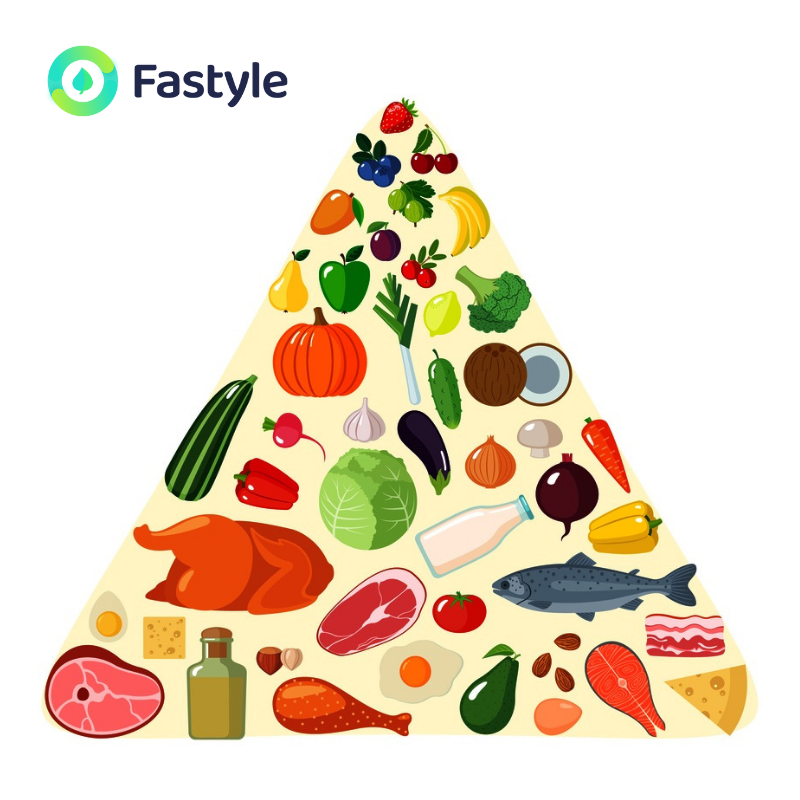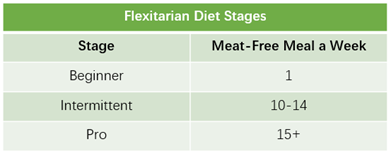One of the essential advantages of intermittent fasting for those expecting to lose weight through it is that intermittent fasting emphasizes the time one eats and has no specific rules on dietary requirements. In order to maintain a healthy and nutritious diet for our body, Fastyle recommends you follow general healthy eating to optimize your results to manage weight and health. Dieting remains the most common approach for weight control nowadays. Although it is easy to combine intermittent fasting with different diets, not all diets are healthy. This article will display some of the diets and nutrition trends that are safe, sustainable, and effective when combined with intermittent fasting.

Flexitarian Diet
This basically means being a flexible vegetarian. There are many different types of vegetarian diets which all have been shown to provide health benefits. But there are also valuable nutrients from animal-based foods that provide health benefits and good tastes. Therefore, the Flexitarian diet is something definitely worth trying.
Flexitarian diet aims to eat predominantly a plant-based diet, while also enjoying meat occasionally. The basic philosophy is simply eating more plants. Following a flexitarian diet can naturally reduce your calorie, saturated fat, and cholesterol intake by eating more plant-based food, and increasing your dietary fiber, mineral, and vitamins which are essential for healthy eating to lose weight.
You can start a Flexitarian diet by having at least 1 meat-free meal per day as a beginner. Once you’re more comfortable being a flexitarian, you can increase your meat-free meals to 10-14 per week (up to 2 meat-free meals per day). Eventually, you can aim for 15 meat-free meals per week.

Mediterranean Diet
Mediterranean diet is a way of eating based on the traditional cuisines of Greece, Italy and other countries around the Mediterranean Sea. Here is a requirement summary of such a diet.
Eat Plenty of:
- Fruits
- Vegetables
- Legumes
- Nuts and seeds
- Cereals
- Whole grains
- Fish
- Seafood
- Herbs
- Spices
- Extra virgin olive oil
Eat Less of:
- Poultry
- Eggs
- Chest
- Low-fat dairy
- Wine
Eat Rarely of:
- Red meat
- Sugar-sweetened beverages
- Added sugar
- Processed meat
- Refined grains
- Refined oils
- Other highly processed foods
Mediterranean diet has been proven to help prevent heart disease, stroke, type 2 diabetes, and lower cholesterol level. Following a Mediterranean diet can also help you achieve the Dietary Guidelines for Americans for a healthy dietary pattern that:
- Emphasizes a variety of fruits and vegetables, wholes grains and beans and legumes.
- Includes low-fat or fat-free products, healthy fats, and lean proteins (fish, poultry).
- And limits added sugar, sodium, saturated fat and highly processed foods.
You can start a Mediterranean diet by eating mostly plant foods and relatively lower in animal food once a week, choosing fish and seafood at least twice a week, having fresh fruits for dessert, and swapping your butter and cooking oil to extra virgin olive oil.

DASH Diet
Dietary Approaches to Stop Hypertension, or DASH diet is a diet designed for people with hypertension (high blood pressure) to manage blood pressure. It emphasizes healthy food sources.
Eats
- Fruits
- Vegetables
- Whole grains
- Low-fat dairy products
- Skinless poultry and fish
- Nuts and legumes
- Non-tropical vegetables oil
Limits
- Saturated and trans fats
- Sodium
- Red meat
- Sweets and sugar-sweetened beverages
Although this diet was originally built for people to manage their high blood pressure by significantly reducing salt intake, the DASH diet also cuts out foods that are high in fat, added sugar and automatically reduces a person’s calories intake to lose weight. If you’re having a diet with mainly processed food or takeaways, you may benefit from switching to the DASH diet to help increase your intake of fresh fruits, vegetables and lean protein, and reduce excess fat, added sugar, sodium, and overall calories intake.

The Volumetric Diet
Volumetric diet or Volume eating is a way to reduce your calories intake while eating a lot of food. To lose weight, you need to burn more calories than you have eaten. Volume eating is the technique to help you choose food with lower calories density in a larger volume while still reducing your daily calories intake to help you lose weight.
Calorie density is the number of calories in a given volume or weight of foods (usually 100 grams). Although some foods are naturally high in calories density, it is still important to include as part of a healthy diet for their essential nutrients, such as oilfish, eggs, vegetable oil, nuts, and seeds. Choosing food with a lower calorie density tends to encourage you to eat more fruits, vegetables, increase your micronutrient, antioxidant, and fiber intake. This will make you feel full and give you better satiety, and therefore less likely to turn to snacks that are calories dense and rich in refined carbohydrates and fats.
A volumetric diet can become your long-term eating pattern since it doesn’t involve calorie counting or cutting out food groups and can be tailored to suit your preferences. Here is a simple guide for you to start on a volumetric diet.
- Step 1. Make sure 50% of your meal/plate is made up of vegetables (non-starchy).
- Step 2. Adjust your protein portion, fill 25% of your plate with lean proteins.
- Step 3. Adjust your carb portion, fill 15 to 20% (less than protein) of your plate with starchy vegetables or whole grains.
- Step 4. Choose a healthier cooking method, such as steam, poach, bake, grill, air fry and stir-fry. Avoid cooking methods calling for large volume of oil or added fat.
A volumetric diet is not a quick weight loss diet but is an approach to help you eat fewer calories and make gradual changes. You should choose a sustainable and nutritionally adequate eating pattern.
Paleo-Inspired Whole Food Diet
A Paleo diet is a dietary mirror of foods eaten by humans during the Paleolithic era. Paleo diet emphasis on fresh lean meats, fish, fruits, vegetables, nuts and seeds, and healthier oils including olive oils and walnut oils. Since our prehistoric ancestors were hunter-gatherers, not farmers, any processed foods are not accepted by a Paleo diet. With such chrematistic, the Paleo diet is high in protein, moderate in fat, low-moderate in carbohydrate (restriction on refining carb), and high in fiber, low in sodium and refined sugar. These features can promote weight loss and provide health benefits.
However, strictly following the Paleo diet can be difficult with prominent limitations difficult to maintain in long term. A Paleo-inspired whole food diet is modified with fewer restrictions on food choices and remains the emphasis on whole foods to provide the same benefits. While including more foods, such as whole grains and low-fat/fat-free dairy, the Paleo-inspired whole food diet still encourages people to stay away from highly processed foods with refined carbohydrates, added salt, and unhealthy fats. So here comes a list of foods for a Paleo-inspired whole food diet.

Low-Carb/Carb-Restricted Diet
A low carb or carb-restricted diet involves reducing your carbohydrate intake, including high carb foods such as bread, rice, pasta, some starchy vegetables, sweets, and sugary drinks. This is often recommended to help blood sugar control, improve insulin sensitivity and promote weight loss for Type 2 Diabetes and manage polycystic ovary syndrome (PCOS).
Atkin and Ketogenic diet are two types of carb restricting diets with an intake of 20-50 grams carbohydrate daily which is difficult to follow in the long term. Instead of starting on such intense carb restrictions, you can start with the diet rules below.
Choosing carbohydrate foods with higher fiber can still help to improve your blood sugar and insulin profile. Reducing carbohydrate intake can help to reduce food cravings and eating less food in general to promote weight loss.

Anti-Inflammatory Diet
Chronic inflammation has been linked to many major diseases such as diabetes, arthritis, heart disease, depression, and Alzheimer’s. Anti-inflammatory foods may lessen the number of flare-ups for inflammation and alleviate symptoms. An anti-inflammatory diet includes foods that are naturally full of antioxidants and polyphenols which may fight inflammation and avoid or limit foods that cause inflammation.
Antioxidants in foods work to reduce free radicals which are created by the body naturally but also lead to inflammation. Eating a balanced diet with more antioxidants from food and reducing foods that promote inflammation would also lower your calories intake which may help to assist weight loss and improve satiety.

Bonus
Meal Kits
A meal kit is great when you don’t know what to eat and what is healthy but also delicious, especially during the pandemic when grocery shopping becomes more difficult than usual. Choosing a health meal kit is a great time-saving solution if you have limited time to make your grocery list and need some help on putting healthy meals together. There is usually a menu selection to meet your personal dietary preferences, and each meal will have a nutrition profile that comes in handy when you want to track your meals on calories, protein, fat, and carbohydrate intake.
Here are some recommendations for meal kits services available in the US for weight management and general healthy meals:
When it comes to picking your meals from the menu, choose the main meal <500kcal and it is made of mostly plant-based foods with some lean protein. If you’re trying to cut calories, choose one meal a day without carbs and snack on fresh fruits and vegetables between main meals.
Chickpeas
This is definitely a food that has been trending over 2021 with it comes in different forms such as Hummus, chickpea bakery, roasted chickpeas snacks, chickpeas pasta, chickpeas chips…
Chickpeas are considered as a legume that is a rich source of vitamins, minerals, fiber, and plant protein. The protein and fiber in chickpeas help you feel full for longer and regulate your food craving by producing appetite-reducing hormones. It is also an excellent alternative to swap to a lower glycemic index carbohydrate source. Replacing refined carbs with chickpeas can reduce the glycemic load of that meal and therefore have a smaller impact on your blood glucose level which also helps keep you full for a longer time. This is a cheap, nutrient-dense, and versatile ingredient, something you should definitely try adding to your diet.

Summary
- Intermittent fasting can be combined with specific diet to enhance its effect and health benefits.
- Not all diets are healthy, and some may do more harm than good.
- Most healthy diets have a similar principle: eating mostly plant-based foods with plenty of fruits and vegetables, some lean protein, moderation in lean meat and dairy and limit highly processed foods with added sugar, fat and excessive alcohol.
- Choose a diet that is easy and sustainable to follow in the long ran rather than a few weeks quick “fix”.